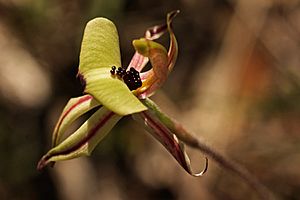Clown orchid facts for kids
Quick facts for kids Clown orchid |
|
|---|---|
 |
|
| Caladenia roei in the Coalseam Conservation Park | |
| Scientific classification | |
| Genus: |
Caladenia
|
| Species: |
roei
|
| Synonyms | |
|
|
The Clown Orchid (scientific name: Caladenia roei) is a special type of orchid. It grows only in the south-west part of Western Australia. This means it is endemic to that area.
People also call it by other fun names. These include the common clown orchid, ant orchid, man orchid, and jack-in-the-box. This plant has one upright, hairy leaf. It can grow up to three greenish-yellow and red flowers. These flowers have a wide labellum, which is like a special lip. You can often find this orchid growing on granite rocks.
Contents
What the Clown Orchid Looks Like
The Clown Orchid is a plant that grows from the ground. It is a perennial herb, meaning it lives for more than two years. It also has a special underground part called a tuber, which stores food. This plant is deciduous, so its leaves might fall off at certain times.
It has one leaf that stands up straight and feels hairy. This leaf is usually about 60 to 150 millimeters (2.4 to 5.9 inches) long. It is also about 5 millimeters (0.2 inches) wide.
The flowers are greenish-yellow and red. They are about 30 to 40 millimeters (1.2 to 1.6 inches) long. They are also 20 to 30 millimeters (0.8 to 1.2 inches) wide. These flowers grow on a stalk that can be 120 to 300 millimeters (4.7 to 11.8 inches) tall.
The sepals are like small leaves that protect the flower. They have thick, yellowish-brown tips that look like clubs. These tips are about 3 to 4 millimeters (0.12 to 0.16 inches) long. The top sepal stands up straight. It is about 15 to 20 millimeters (0.59 to 0.79 inches) long and 2 millimeters (0.079 inches) wide. It often curves forward a little.
The side sepals and petals are similar in size to the top sepal. They point downwards, making the flower look a bit like a cross. The labellum, or lip, of the flower is very interesting. It is 8 to 11 millimeters (0.31 to 0.43 inches) long and 13 to 16 millimeters (0.51 to 0.63 inches) wide. It is greenish-yellow with a small red tip that curls underneath.
The sides of the labellum are smooth. But in the middle, there is a thick band of dark reddish-purple bumps. These bumps are called calli and are up to 1.5 millimeters (0.059 inches) long. You can see the Clown Orchid flowering from August to October.
How it Got its Name
The Caladenia roei was first officially described in 1873. This was done by a person named Alex George. The description was put into a book called Flora Australiensis.
The second part of its scientific name, roei, is a special honor. It was named after John Septimus Roe.
Where the Clown Orchid Lives
The Clown Orchid can be found in many places across the south-west of Western Australia. It grows as far north as the Murchison River. It also grows as far east as Ravensthorpe.
You can find it in different types of places. However, it is especially common on granite outcrops. These are places where large rocks stick out of the ground.
Protecting the Clown Orchid
The Western Australian Government's Department of Parks and Wildlife checks on plants. They have said that Caladenia roei is "not threatened." This means it is not in danger of disappearing.
See also
 In Spanish: Caladenia roei para niños
In Spanish: Caladenia roei para niños

